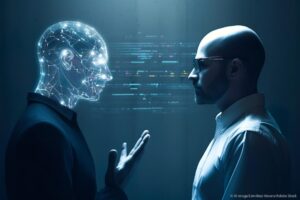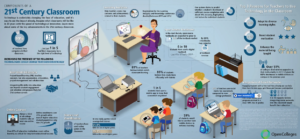
Good Day to each one of you!! In the first two debates I think I was in a different mode so did not explain much about my thinking and analyzing but in the remaining three debates I will try and do justice to my analysis.
AI in education- Like every other technology we have come across, we do have resistance to everything new, and possibly this resistance is the cause of debate. But, like every change we have encountered, I think we will give in to the AI revolution because, we have a lot to gain from it.
Our two debating teams, like each one before this, started with the agreeing side giving their opening statements and there was a lot of explanation about how AI helps in differentiation and it is adaptive to each student’s skill set, which is not there in traditional classrooms. The traditional way of teaching was conceived around 200 years ago to produce people who were suited for employment. It is also generally known that if there is one person who cannot do the job, then there could be a next one who could fill in, causing no loss in the factory where they are employed. In this way, almost all traditional learning systems set about their philosophies to cultivate children who were a carbon copy of each other. I do not deny that even I, who did my schooling in the 80’s and university in the 90’s is a product of the same system. There could be nothing different because that was frowned upon and treated like so. (How old! I can imagine some of you thinking! I wasn’t even born at that time!!)
AI also boasts about bringing intelligent learning systems to the classroom that enhance learning. It also explains how instant feedback helps in categorizing pupils according to their needs. Students can also work on their limitations and in that way work to improve their learning. AI is also bringing streamlined administrative task procedures that help teachers in creating an environment that emphasizes only learning in the classroom. Other related paperwork could be dealt with by AI technology.
Predictive analytical student success can be backed by AI tools that help each child reach their maximum potential. When we notice that a student is becoming disinterested in studying, tools related to AI can assist in creating programs that ensure each student’s success. There are different structures within the learning systems that will be assisted by AI and its utilization cannot be denied. AI also sets to use correct translation techniques that help in creating courses that can be done in a person own language rather than in only English.
On the disagree side, the opening stance was a person speaking that we thought was one of the speakers but it was an AI-generated voice. It stuck with me and was surprising!! The first counter-argument that they had was that AI dehumanizes education and the narrative that AI is enhancing the educational process is being pushed by people invested in the technology and they have an ulterior motive in promoting it. They also emphasized that as learners become dependent on AI, they become passive in the process and therefore, this limits their development. Teaching, in itself, is a two-way process that engages the teacher and the learner. Can we expect an automated robot to do the same for a child? Going further, will this create a system where teachers will no longer be needed?
AI is potentially a non-emotional system and its programming has been created by humans. Does it also hold the same biases that the human who has built it holds? Possibly, they explain by giving examples of various employments that are categorized according to gender.
One very important fact to consider is that AI can be used by students to create systems that do not actually support them but in fact, be a crutch, meaning they give them the answers instead of developing the critical thinking skills that teachers want them to cultivate. One essential point of consideration is also about access to a web-enabled device and broadband access. They also questioned the need for having AI systems in place for students because it compromises privacy and security.
Reading through the various articles linked in the sign-up sheet, I was intrigued to see an article from UNESCO on AI and how it could both innovate and destroy the learning systems prevalent today. Almost everywhere around the world, we notice the technological divide between the haves and the have-nots. But the fruits of technology need to be accessible to everyone. The article also proposes a guideline to professionals related to policy making and other communities to foster readiness for the opportunities and challenges provided by AI and its implications.
The next article explains how AI could be used to cheat. Students could use an AI generator to write articles in their name. The writer gives examples of how he used an AI text generator called Sudowrite to create sample texts. Going ahead in the article, the author talks about how some programs that check grammar and syntax could be considered acceptable. Considering the borderline between using assistive devices, AI could be used as a tool for enhancing learning for some students who need it. I found one quote from this article spot on.
“It goes back to teachers’ objectives and students’ needs,” she said. “There’s a fine balance making sure both of those are met.”
Talking about the articles on the disagreeing side, the first article was about how New York schools have banned AI chatbot designs from schools, especially for writing essays and other academic articles. They fear that AI will create systems for cheating and will diminish the development of critical thinking and other essential skills.
The next article was about how AI could synthesize voice patterns of individuals based on a 3-second audio pattern obtained from any acoustic device. The AI simulates the pattern with other voice content that is in the database and prepares a voice sample based on it. Since there is potential for misuse of the model, there is a chance for spoofing a speaker or impersonation.
The last article speaks about Microsoft’s 10 Bn investment in AI. They also explain how various companies are following suit. AI is now being used for their products. They have started to recognize that AI is going to support every profession and product that is being produced.
Coming to the debate, the discussion followed similar lines to the opening statement. The agreeing side started to argue about differentiation and AI’s implication for the same. They also spoke about the need for change to a system of education that is almost 2 centuries old. The disagreeing side, on the contrary, spoke about how education is an emotional phenomenon and it needs the teacher to make sense of the world. Robots cannot be possibly used for teaching as they lack the empathetic skills needed. The agree side elucidated the help of AI in creating systems that support teachers and make their lives easier by assisting in administrative tasks. They also support the enhancement of skills.
Many classmates spoke both for and against the topic. An interesting tool that was explained was Eduaide which supports teachers in various ways. Data collection through this process is easier and ultimately the support that the teacher receives empowers her and her classroom, in return. Goblin tools is one more tool that could be used in classrooms by teachers. The disagreeing side spoke about an unambiguity in policy and its effect on the usage.
Katia spoke about AI detectors for plagiarism and their effects. There was a lot of discussion on translation and whether it can be viewed as plagiarism. In conclusion, the agreeing side spoke about how we cannot expect AI or robots to take over the education field and we should not expect joblessness. In fact, AI helps gain knowledge, establish frameworks, and maximize technological learning. The disagreeing side spoke about the dehumanizing content and how teachers are models for gathering knowledge, beliefs, and attitudes. They also spoke about data privacy and the unregulated structure of AI.
Looking at the articles posted by both sides, the agreeing team added the first article about the use of AI in education and how it is being viewed as the Fourth Industrial Revolution or 4.0. It does speak about teacher shortages around the world and how the gap can be bridged through automation and augmentation. Refining assessment and analytical testing and the implementation of AI tools within the same parameters are important in education, according to them. Personalizing content and supporting digital literacy are two very important and dominant themes under the AI scheme and developing these skills creates a workforce that is driven by the needs of the 21st Century. The video that they presented was similar to some of the things they described in their debate, like how the schools were initially set to produce a workforce for factories (discussed earlier in the blog.)
On the disagree side, all three articles spoke about issues that arise out of having AI instruments in the classroom. The Kehlenbach article questioned the need for AI and exposing our children to the social problems associated. The article on AI being a threat to student privacy is very real and I asked myself twice if I need to track the steps I take while going out on the back and even storing it for future reference is worth it. The bias issue as mentioned in the third article has been discussed previously in the blog so I will not discuss it further.
Like all previous debates, I enjoyed this one too. I am a flexible person who enjoys technology and is always looking for venues to better myself and my teaching through it. But I do not see it as invading my space as a teacher. And I do not see it as a threat. Adopting a balanced view of how best I can improve my pedagogy through technology is my view of engaging with it.



 A typical day in my life revolves around communication with my family, friends, and social connections, facilitated by technology. Living in a remote community in Northern Ontario
A typical day in my life revolves around communication with my family, friends, and social connections, facilitated by technology. Living in a remote community in Northern Ontario 
